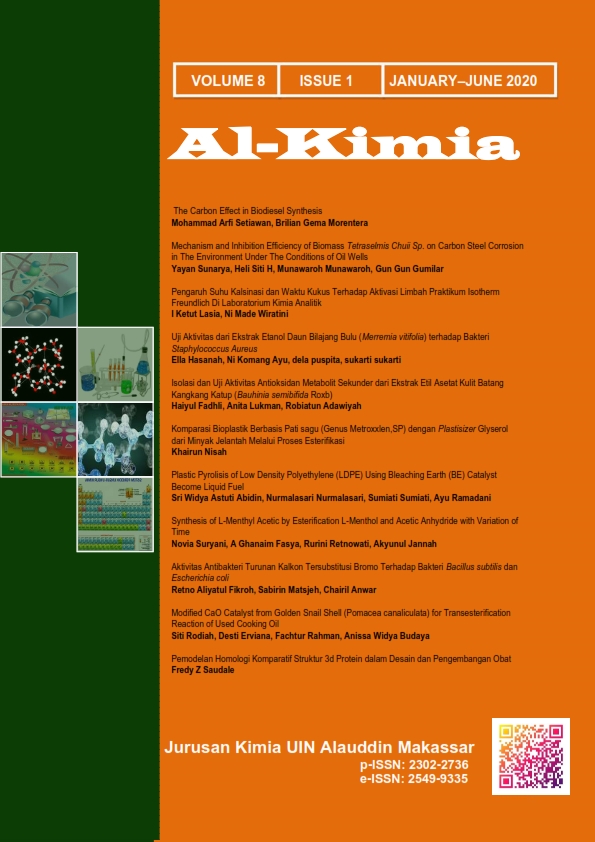Isolasi dan Uji Aktivitas Antioksidan Metabolit Sekunder dari Ekstrak Etil Asetat Kulit Batang Kangkang Katup (Bauhinia semibifida Roxb)
Abstrak
Antioxidant was a compound which possessed an activity as scavenger of free radicals. This study was aimed to examine the antioxidant activity of ethyl acetate fraction and isolated compound from stem barks of Bauhinia semibifida Roxb. Samples extracted by gradual maceration with n-hexane solvent, ethyl acetate and methanol respectively. Isolation was carried out using Vacuum Liquid Chromatrography and purification by column chromatography with Sephadex LH-20. Isolated compound (BS) obtained was ivory crystalline with melting point 163-1650C. The analysis of FT-IR spectra, UV spectra and the result of qualitative test by Liebermann Burchard reagent were is shown positive as a terpenoid. Antioxidant activity were evaluated by using DPPH method for ethyl acetate fraction and isolation compound in serial concentration of 1000; 500; 250; 125; 62,5; 31,25 ug/mL. The result found that ethyl acetate fraction (f4 and f11) of stem barks of Bauhinia semibifida showed antioxidant activity with IC50 value of >1000 ug/mL; 179 ug/mL. In conclusion, F11 from ethyl acetate extract from stem barks of Bauhinia semibifida Roxb. exhibited an activity as scavenger of free radicals from DPPH.
Keywords: Antioxidant, Bauhinia semibifida Roxb, IC50, VLC
##plugins.generic.usageStats.downloads##
Referensi
Ayucitra, A., Indraswati, N., Francisco, G. & Yudha, A. 2013. Potensi Senyawa Fenolik Bahan Alam Sebagai Antioksidan Alami Minyak Goreng Nabati. Widya Teknik, 10(1): 1–10.
Demirezer, L.Ö., Kuruüzüm-Uz, A., Bergere, I., Schiewe, H.-J. & Zeeck, A. 2001. The Structures of Antioxidant and Cytotoxic Agents from Natural Source: Anthraquinones and Tannins from Roots of Rumex patientia. Phytochemistry, 58(8): 1213–1217.
Fadhli, H., Furi, M. & Jauwahir, A. 2019. Isolasi dan Uji Aktivitas Antioksidan Fraksi Alkaloid dari Ekstrak Metanol Kulit Batang Bunga Kupu-kupu (Bauhinia semibifida Roxb.). Jurnal Penelitian Farmasi Indonesia, 7(2): 43–50.
Fadhli, H., Nurdin, A.N. & Octaviani, M. 2018a. Potensi Antioksidan dari Ekstrak Kulit Batang Bauhinia semibifida Roxb. Jurnal Ilmiah Ibnu Sina, 4(1): 77–87.
Fadhli, H., Soeharto, A.B.R. & Windarti, T. 2018b. Uji Aktivitas Antioksidan Kulit Buah Pulasan (Nephelium mutabile Blume) dan Bunga Turi Putih (Sesbania grandiflora) dengan Metoda DPPH. Jurnal Katalisator, 3(2): 114–124.
Fitmawati, F., Sofiyanti, N., Roza, R.M., Isnaini, I., Irawan, Y.R., Winata, D.R. & Dewi, A.P.K. 2017. Antioxidant Activity of Dominant Plants Species in Obat Pahit from Lingga Malay Ethnic in Riau Archipelago. Biosaintifika: Journal of Biology & Biology Education, 9(2): 325–331.
Hanani, E. 2016. Analisis Fitokimia. Jakarta :EGC: Buku Kedokteran EGC.
Hostettmann, K., Hostettman, M. & Marston, A. 1995. Cara Kromatografi Preparatif Penggunaan pada Senyawa Bahan Alam. Bandung: Penerbit ITB.
Kedare, S.B. & Singh, R.P. 2011. Genesis and Development of DPPH Method of Antioxidant Assay. Journal of Food Science and Technology, 48(4): 412–422.
Lovadi, I. & Linda, R. 2015. Pemanfaatan Tumbuhan dalam Pengobatan Tradisional Masyarakat Suku Dayak Kanayatn di Desa Ambawang Kecamatan Kubu Kabupaten Kubu Raya. Protobiont, 4(3): 49–59.
Parwata, I.M.O.A., Rita, W.S. & Yoga, R. 2009. Isolasi dan Uji Antiradikal Bebas Minyak Atsiri pada Daun Sirih (Piper betle Linn) Secara Spektroskopi Ultra Violet-Tampak. Jurnal kimia, 3(1): 7–13.
Sastrohamidjojo, H. 2013. Dasar-dasar Spektroskopi. Yogyakarta: UGM Press.
Tanjung, M. & Tjahjandarie, T.S. 2014. Flavonoids from the Stem Bark of Bauhinia semibifida L. Der Pharmacia Lettre, 6(6): 434–438.
Tjitrosoepomo, G. 1994. Taksonomi Tumbuhan Obat-obatan. Yogyakarta: Gadjah Mada University Press.
Zhang, L., Tu, Z., Yuan, T., Wang, H., Xie, X. & Fu, Z. 2016. Antioxidants and a-Glucosidase Inhibitors from Ipomoea batatas Leaves Identified by Bioassay-Guided Approach and Structure-Activity Relationships. Food Chemistry, 208: 61–67.
Zhang, Q., Zhang, J., Shen, J., Silva, A., Dennis, D.A. & Barrow, C.J. 2006. A Simple 96-Well Microplate Method for Estimation of Total Polyphenol Content in Seaweeds. Journal of Applied Phycology, 18(3–5): 445–450.
##submission.copyrightStatement##
##submission.license.cc.by-nc-sa4.footer##Authors who publish with this journal agree to the following terms:
1) Authors retain copyright and grant the journal right of first publication with the work simultaneously licensed under a Creative Commons Attribution License that allows others to share the work with an acknowledgement of the work's authorship and initial publication in this journal.
2) Authors are able to enter into separate, additional contractual arrangements for the non-exclusive distribution of the journal's published version of the work (e.g., post it to an institutional repository or publish it in a book), with an acknowledgement of its initial publication in this journal.
3)Authors are permitted and encouraged to post their work online (e.g., in institutional repositories or on their website) prior to and during the submission process, as it can lead to productive exchanges, as well as earlier and greater citation of published work (See The Effect of Open Access).


